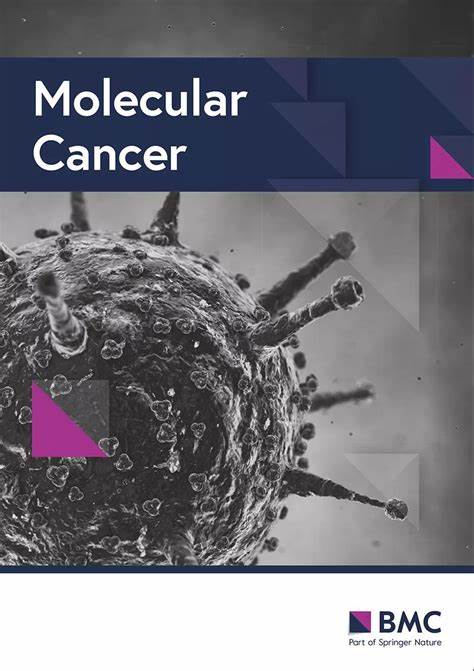癌细胞细胞内短暂表达PD-L1和VEGFR2双特异性纳米体,激发T细胞长期活化和浸润,以对抗肿瘤,抑制肿瘤转移
IF 27.7
1区 医学
Q1 BIOCHEMISTRY & MOLECULAR BIOLOGY
引用次数: 0
摘要
免疫检查点抑制剂PD-L1和VEGFR2在肿瘤发生中起关键作用,VEGFR2是肿瘤转移所必需的。然而,结合检查点阻断和抗转移抗癌治疗的微型双特异性细胞内纳米体仍未得到充分开发。利用基因克隆技术对其进行了克隆。采用Western blot、共免疫沉淀(co-IP)分析、抗体竞争结合试验、流式细胞术分析等方法证实了抗体的特异性。使用抗体-抗原竞争结合试验证明检查点阻断。用划痕法测定癌细胞迁移。在小鼠模型体内测定FAP1V2联合抗癌的治疗效果。流式细胞术检测PD-1hi免疫细胞、TCR βhi和CD25hi t细胞,免疫荧光法检测肺、肝组织癌细胞转移情况。转录组分析用于探索与增强抗癌效率相关的信号通路。双特异性体内FAP1V2与抗体VH区融合,成功开发并验证了其靶向和阻断人和小鼠PD-L1和VEGFR2的能力,抑制癌细胞与PD-1的结合并降低其迁移能力。与其他处理相比,两轮FAP1V2在实验小鼠模型LLC细胞中的瞬时表达取得了显著的肿瘤抑制作用,对1/6的实验小鼠LLC第二轮肿瘤的生长产生了完全的免疫抑制,激发了TCR βhi T细胞的长期活化,增加了它们对肿瘤的浸润,抑制了PD-1hi免疫细胞的出现,表明阻止了T细胞的耗用。CD25表达的升高也支持了脾脏中T细胞活性升高所报道的增强免疫应答的成功。转录组分析确定了由PD-L1和VEGFR2同时阻断调节的关键细胞内通路。PD-L1和VEGFR2-双特异性VH细胞内纳米体具有高度的生物相容性,并通过PD-L1/PD-1检查点阻断介导的长期免疫激活和VEGFR2阻断介导的抗转移,显示出联合抗癌治疗的潜力。本文章由计算机程序翻译,如有差异,请以英文原文为准。
Transient intracellular expression of PD-L1 and VEGFR2 bispecific nanobody in cancer cells inspires long-term T cell activation and infiltration to combat tumor and inhibit cancer metastasis
PD-L1, an immune checkpoint inhibitor, and VEGFR2, essential for cancer metastasis, play pivotal roles in tumorigenesis. However, their miniature bispecific intracellular nanobodies for combining check-point blockade and anti-metastasis anticancer therapy remain underexplored. The intrabodies were developed using gene cloning technology. Specificity of the intrabodies was testified using Western blot, co-immunoprecipitation (co-IP) analysis, antibody competitive binding assay, flow cytometry analysis, etc. Checkpoint blockade was demonstrated using antibody-antigen competitive binding assay. Cancer cell migration was determined using scratch assay. Combined anti-cancer therapeutic efficacy of FAP1V2 was determined in vivo of mice models. The PD-1hi immune cells, TCR βhi and CD25hi T-cells were analyzed by flow cytometry, and cancer cell metastasis was performed using immune-fluorescence analysis on lung and liver tissues. Transcriptome analysis was performed to explore signaling pathways associated with the enhanced anticancer efficiency. Bispecific intrabody FAP1V2 fused with antibody VH regions, was successfully developed and verified with its ability to target and block human and mouse PD-L1 and VEGFR2, inhibiting cancer cell binding to PD-1 and reducing their migratory capacity. Compared to the other treatment, two-rounds of transient FAP1V2 expression in LLC cells in experimental mice models achieved remarkable tumor inhibition, which brought about complete immune inhibition on growth of secondary-round of LLC tumor in 1/6 of the tested mice, inspired long-term activation of TCR βhi T cells and increased their infiltration to tumors, inhibited the emergence of PD-1hi immune cells, indicating prevented T cell depletion. The elevated CD25 expression also supported the success in enhancing immune response reported by elevated T cell activity in spleen. Transcriptome analysis identified critical intracellular pathways regulated by the concurrent blockade of PD-L1 and VEGFR2. PD-L1 and VEGFR2- bispecific VH intracellular nanobody was highly biocompatible and showed the potential for combined anti-cancer therapy through long-term immune activation mediated by PD-L1/PD-1 checkpoint blockade and anti-metastasis mediated by VEGFR2 blockade.
求助全文
通过发布文献求助,成功后即可免费获取论文全文。
去求助
来源期刊

Molecular Cancer
医学-生化与分子生物学
CiteScore
54.90
自引率
2.70%
发文量
224
审稿时长
2 months
期刊介绍:
Molecular Cancer is a platform that encourages the exchange of ideas and discoveries in the field of cancer research, particularly focusing on the molecular aspects. Our goal is to facilitate discussions and provide insights into various areas of cancer and related biomedical science. We welcome articles from basic, translational, and clinical research that contribute to the advancement of understanding, prevention, diagnosis, and treatment of cancer.
The scope of topics covered in Molecular Cancer is diverse and inclusive. These include, but are not limited to, cell and tumor biology, angiogenesis, utilizing animal models, understanding metastasis, exploring cancer antigens and the immune response, investigating cellular signaling and molecular biology, examining epidemiology, genetic and molecular profiling of cancer, identifying molecular targets, studying cancer stem cells, exploring DNA damage and repair mechanisms, analyzing cell cycle regulation, investigating apoptosis, exploring molecular virology, and evaluating vaccine and antibody-based cancer therapies.
Molecular Cancer serves as an important platform for sharing exciting discoveries in cancer-related research. It offers an unparalleled opportunity to communicate information to both specialists and the general public. The online presence of Molecular Cancer enables immediate publication of accepted articles and facilitates the presentation of large datasets and supplementary information. This ensures that new research is efficiently and rapidly disseminated to the scientific community.
 求助内容:
求助内容: 应助结果提醒方式:
应助结果提醒方式:


